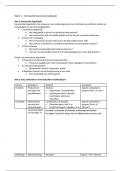Samenvatting
Samenvatting 'Living in the Environment'
Dit is een samenvatting voor het vak Milieuproblemen van de studie Landscape and Environment Management. Het boek dat hiervoor gebruikt is, is 'Living in the Environment.' De hoofdstukken die zijn samengevat zijn: H1, H3, H6, H15, H16, H18, H19, H21, H23 en H25.
[Meer zien]













